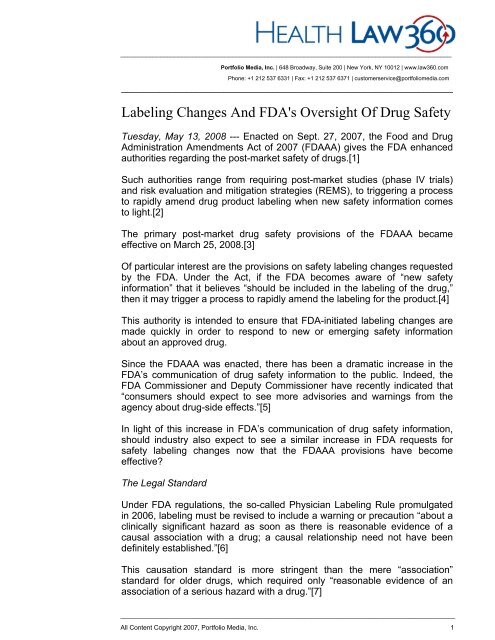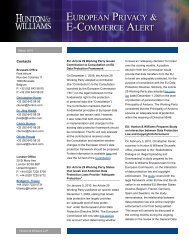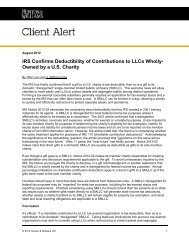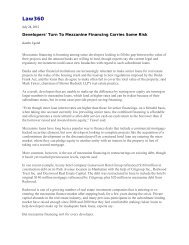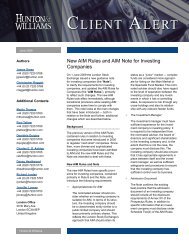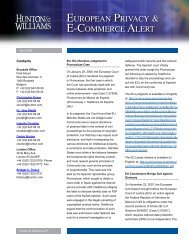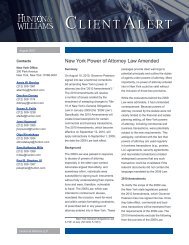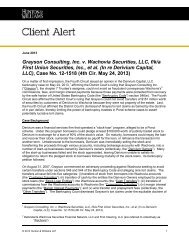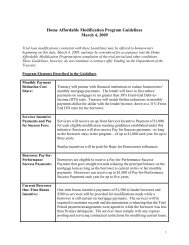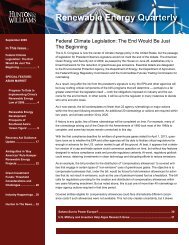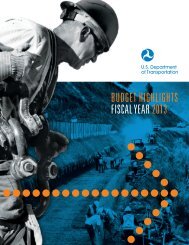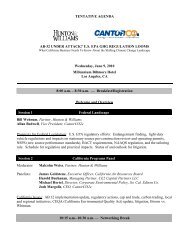Labeling Changes and FDA's Oversight of Drug Safety, Health Law ...
Labeling Changes and FDA's Oversight of Drug Safety, Health Law ...
Labeling Changes and FDA's Oversight of Drug Safety, Health Law ...
Create successful ePaper yourself
Turn your PDF publications into a flip-book with our unique Google optimized e-Paper software.
____________________________________________________________________________________________<br />
Portfolio Media, Inc. | 648 Broadway, Suite 200 | New York, NY 10012 | www.law360.com<br />
Phone: +1 212 537 6331 | Fax: +1 212 537 6371 | customerservice@portfoliomedia.com<br />
______________________________________________________________________<br />
<strong>Labeling</strong> <strong>Changes</strong> And <strong>FDA's</strong> <strong>Oversight</strong> Of <strong>Drug</strong> <strong>Safety</strong><br />
Tuesday, May 13, 2008 --- Enacted on Sept. 27, 2007, the Food <strong>and</strong> <strong>Drug</strong><br />
Administration Amendments Act <strong>of</strong> 2007 (FDAAA) gives the FDA enhanced<br />
authorities regarding the post-market safety <strong>of</strong> drugs.[1]<br />
Such authorities range from requiring post-market studies (phase IV trials)<br />
<strong>and</strong> risk evaluation <strong>and</strong> mitigation strategies (REMS), to triggering a process<br />
to rapidly amend drug product labeling when new safety information comes<br />
to light.[2]<br />
The primary post-market drug safety provisions <strong>of</strong> the FDAAA became<br />
effective on March 25, 2008.[3]<br />
Of particular interest are the provisions on safety labeling changes requested<br />
by the FDA. Under the Act, if the FDA becomes aware <strong>of</strong> “new safety<br />
information” that it believes “should be included in the labeling <strong>of</strong> the drug,”<br />
then it may trigger a process to rapidly amend the labeling for the product.[4]<br />
This authority is intended to ensure that FDA-initiated labeling changes are<br />
made quickly in order to respond to new or emerging safety information<br />
about an approved drug.<br />
Since the FDAAA was enacted, there has been a dramatic increase in the<br />
FDA’s communication <strong>of</strong> drug safety information to the public. Indeed, the<br />
FDA Commissioner <strong>and</strong> Deputy Commissioner have recently indicated that<br />
“consumers should expect to see more advisories <strong>and</strong> warnings from the<br />
agency about drug-side effects.”[5]<br />
In light <strong>of</strong> this increase in FDA’s communication <strong>of</strong> drug safety information,<br />
should industry also expect to see a similar increase in FDA requests for<br />
safety labeling changes now that the FDAAA provisions have become<br />
effective?<br />
The Legal St<strong>and</strong>ard<br />
Under FDA regulations, the so-called Physician <strong>Labeling</strong> Rule promulgated<br />
in 2006, labeling must be revised to include a warning or precaution “about a<br />
clinically significant hazard as soon as there is reasonable evidence <strong>of</strong> a<br />
causal association with a drug; a causal relationship need not have been<br />
definitely established.”[6]<br />
This causation st<strong>and</strong>ard is more stringent than the mere “association”<br />
st<strong>and</strong>ard for older drugs, which required only “reasonable evidence <strong>of</strong> an<br />
association <strong>of</strong> a serious hazard with a drug.”[7]<br />
_____________________________________________________________________________________________<br />
All Content Copyright 2007, Portfolio Media, Inc. 1
____________________________________________________________________________________________<br />
The FDA has emphasized repeatedly that labeling changes are to be made<br />
based on a comprehensive scientific evaluation <strong>of</strong> the product’s risks <strong>and</strong><br />
benefits according to legal st<strong>and</strong>ards set forth in the Agency’s regulations,<br />
not in response to safety fears that are unfounded.<br />
For example, in the preamble to the Physician <strong>Labeling</strong> Rule, the agency<br />
stated that “labeling that includes theoretical hazards not well-grounded in<br />
scientific evidence can cause meaningful risk information to ‘lose its<br />
significance.’”[8]<br />
The legal st<strong>and</strong>ard justifying the FDA to request a drug manufacturer to add<br />
a warning or precaution to drug product labeling – “reasonable evidence <strong>of</strong> a<br />
causal association” between the drug <strong>and</strong> “a clinically significant hazard” – is<br />
unchanged by the FDAAA. Nothing in the FDAAA displaced the Physician<br />
<strong>Labeling</strong> Rule or established any other st<strong>and</strong>ard.<br />
To the contrary, the FDAAA merely established a process to rapidly amend<br />
the labeling <strong>of</strong> the drug at issue, if the FDA “becomes aware <strong>of</strong> new safety<br />
information that [it] believes should be included in the labeling.”[9]<br />
This conclusion is supported by the FDA’s recently published proposed rule<br />
on supplement applications proposing labeling changes for approved drugs<br />
(commonly referred to as “changes being effected supplements” or “CBE<br />
supplements”).[10]<br />
This proposed rule would require that changes to labeling be based upon<br />
“evidence <strong>of</strong> causal association” that satisfies the causation st<strong>and</strong>ard set<br />
forth in the Physician <strong>Labeling</strong> Rule, i.e., “reasonable evidence <strong>of</strong> a causal<br />
association” between the drug <strong>and</strong> “a clinically significant hazard.”[11]<br />
Importantly, the Agency acknowledged in the preamble to the proposed CBE<br />
rule that changes to labeling under the new FDAAA drug safety provisions,<br />
like CBE changes under the proposed rule, also must satisfy the Physician<br />
<strong>Labeling</strong> Rule’s causation st<strong>and</strong>ard: “FDA believes that its underst<strong>and</strong>ing <strong>of</strong><br />
[the proposed CBE rule’s st<strong>and</strong>ard] as reflected in this document is<br />
consistent with this enhanced authority [under the FDAAA drug safety<br />
provisions] for FDA to control the labeling for drugs <strong>and</strong> biologics.”[12]<br />
Thus, labeling changes – whether sponsor-initiated under CBE regulations or<br />
FDA-initiated under the new FDAAA provisions – must be based on<br />
reasonable evidence <strong>of</strong> a causal association between the drug <strong>and</strong> a<br />
clinically significant hazard.<br />
As the Agency itself has said, this uniform st<strong>and</strong>ard “ensures that only<br />
scientifically justified information is provided in the labeling for an approved<br />
product. Exaggeration <strong>of</strong> risk, or inclusion <strong>of</strong> speculative or hypothetical risks,<br />
could discourage appropriate use <strong>of</strong> a beneficial drug ... or decrease the<br />
usefulness <strong>and</strong> accessibility <strong>of</strong> important information by diluting or obscuring<br />
it ... [L]abeling that includes theoretical hazards not well-grounded in<br />
_____________________________________________________________________________________________<br />
All Content Copyright 2007, Portfolio Media, Inc. 2
____________________________________________________________________________________________<br />
scientific evidence can cause meaningful risk information to lose its<br />
significance.”[13]<br />
Accordingly, because the legal st<strong>and</strong>ard has not changed, <strong>and</strong> because the<br />
policy bases supporting that st<strong>and</strong>ard remain valid, <strong>and</strong> because drugs have<br />
not somehow become more dangerous in the months since the FDAAA was<br />
enacted, drug manufacturers should not expect a dramatic increase in FDA<br />
requests for safety labeling changes. Or should they?<br />
FDA Requests For <strong>Labeling</strong> <strong>Changes</strong><br />
An early indicator <strong>of</strong> the manner in which the FDA, in practice, may<br />
implement the FDAAA’s drug safety labeling provisions may be the case <strong>of</strong><br />
the erectile dysfunction drugs Cialis, Levitra, <strong>and</strong> Viagra, <strong>and</strong> the drug<br />
Revatio, used to treat pulmonary arterial hypertension.<br />
These drugs are all members <strong>of</strong> a drug class known as PDE5 inhibitors. In<br />
October 2007, shortly after the FDAAA was enacted, the FDA announced<br />
that it had “asked manufacturers <strong>of</strong> these drugs to revise product labeling<br />
after a very small number <strong>of</strong> patients taking the PDE5 inhibitors reported<br />
sudden hearing loss, sometimes accompanied by ringing in the ears <strong>and</strong><br />
dizziness.”[14]<br />
In doing so, the FDA admitted that “no causal relationship [between PDE5<br />
inhibitors <strong>and</strong> sudden hearing loss] has been demonstrated,” but it<br />
nonetheless determined the limited number <strong>of</strong> adverse events “warrants<br />
revisions to the product labeling for this drug class.”[15]<br />
Indeed, the Agency c<strong>and</strong>idly acknowledged that the absence <strong>of</strong> relevant data<br />
made “it difficult to determine whether these reports are directly related to the<br />
use <strong>of</strong> one <strong>of</strong> these drugs, an underlying medical condition, or other risk<br />
factors for hearing loss, a combination <strong>of</strong> these factors, or other factors.”[16]<br />
Notwithst<strong>and</strong>ing the absence <strong>of</strong> reasonable evidence <strong>of</strong> a causal relationship<br />
between PDE5 inhibitors <strong>and</strong> sudden hearing loss, the manufacturers <strong>of</strong><br />
these PDE5 inhibitors voluntarily agreed to revise the warning <strong>and</strong> precaution<br />
section <strong>of</strong> the labels <strong>of</strong> their drugs.<br />
The FDA’s action on PDE5 inhibitors is not unique. In November 2007, the<br />
FDA issued an “early communication” that advised that patients using<br />
Chantix, a smoking-cessation drug, had reported side effects including<br />
depression <strong>and</strong> suicidal behavior.<br />
The early communication stated that FDA’s posting <strong>of</strong> the “information does<br />
not mean that FDA has concluded there is a causal relationship between the<br />
drug products <strong>and</strong> the emerging safety issue.”[17]<br />
Pfizer, the manufacturer <strong>of</strong> Chantix, voluntarily agreed to add warnings to the<br />
drug’s labeling, but stated that a “causal relationship between Chantix <strong>and</strong><br />
these reported symptoms has not been established.”[18]<br />
_____________________________________________________________________________________________<br />
All Content Copyright 2007, Portfolio Media, Inc. 3
____________________________________________________________________________________________<br />
On Feb. 1, 2008, FDA issued a public health alert about Chantix that said, “it<br />
appears increasingly likely that there is an association between Chantix <strong>and</strong><br />
serious neuropsychiatric symptoms,” <strong>and</strong> noted that Pfizer had agreed to add<br />
a warning to the label.[19]<br />
In a conference call on the Chantix public health alert, the senior FDA doctor<br />
on the call was pressed on whether there was reasonable evidence <strong>of</strong> a<br />
causal association between Chantix <strong>and</strong> increased depression <strong>and</strong><br />
suicidality, as had been reported by some users <strong>of</strong> Chantix.<br />
In response, he conceded that, although Pfizer voluntarily agreed to make<br />
the labeling change FDA wanted, the legal st<strong>and</strong>ard for m<strong>and</strong>ating such a<br />
labeling change had not been met.<br />
In response to a question about causation, he stated “that what I meant to<br />
say is that it’s certainly possible that these are related. We have no definitive<br />
evidence that there is a causal relationship here; it’s just that they are<br />
strongly appearing to be related. And as we go further with our review, we<br />
may reach a level where we believe that there is clear causality, but we have<br />
not gotten there yet.”[20]<br />
Similarly, on March 5, 2008, it was reported that Roche <strong>and</strong> GlaxoSmithKline<br />
(GSK), at the FDA’s urging, had revised the labels <strong>of</strong> the influenza drugs,<br />
Tamiflu <strong>and</strong> Relenza.[21]<br />
Roche <strong>and</strong> GSK both revised the warnings <strong>and</strong> precautions section <strong>of</strong><br />
Tamiflu <strong>and</strong> Relenza labels to inform doctors <strong>of</strong> certain “neuropsychiatric<br />
events associated with the use <strong>of</strong>” the drugs, “in patients with influenza,” that<br />
“in some cases result[ed] in fatal outcomes.”[22]<br />
The safety alert issued by FDA, as well as the revised labels, acknowledged<br />
that the contribution <strong>of</strong> the drugs to the neuropsychiatric events “has not<br />
been established.”[23]<br />
The impetus for the requested labeling changes were studies <strong>of</strong> patients in<br />
Japan who took Tamiflu <strong>and</strong> reported experiencing certain neuropsychiatric<br />
events, such as delirium, delusions <strong>and</strong> hallucinations. As FDA regulators<br />
conceded, however, delirium <strong>and</strong> other such neuropsychiatric events can be<br />
complications <strong>of</strong> influenza itself.[24]<br />
Moreover, it appears that the FDA requested changes to the label for<br />
Relenza merely because it is in the same class <strong>of</strong> drugs as Tamiflu, not<br />
because <strong>of</strong> reports <strong>of</strong> adverse events caused by the use <strong>of</strong> Relenza (let<br />
alone reasonable evidence <strong>of</strong> a causal association between Relenza <strong>and</strong> a<br />
clinically significant hazard).<br />
Indeed, because Relenza, which is inhaled orally, is not easily absorbed,<br />
“experts said the problems probably were related to the influenza rather than<br />
the treatment.”[25]<br />
_____________________________________________________________________________________________<br />
All Content Copyright 2007, Portfolio Media, Inc. 4
____________________________________________________________________________________________<br />
Finally, the reports <strong>of</strong> adverse events were mostly from Japan, “where<br />
Tamiflu <strong>and</strong> Relenza are used not just to treat influenza but to prevent it,<br />
[<strong>and</strong>] some children are on the drugs for as long as seven weeks. In the<br />
United States, the drugs primarily are used to treat illness, <strong>and</strong> children<br />
typically are on them for five days or less.”[26]<br />
Conclusion<br />
It should come as no surprise that, as an institutional matter, the FDA is<br />
inclined to err on the side <strong>of</strong> taking action when it comes to drug safety. After<br />
all, the Agency has, in recent years, been subject to withering criticism from<br />
Congress <strong>and</strong> in the media about its h<strong>and</strong>ling <strong>of</strong> drug safety issues.[27]<br />
The new FDAAA drug safety provisions, even though they do not establish a<br />
new, less stringent st<strong>and</strong>ard for m<strong>and</strong>ating labeling changes, unquestionably<br />
reveal Congress’ concern about the FDA’s post-market oversight <strong>of</strong> drug<br />
safety.<br />
As the FDAAA’s new drug safety labeling provisions go into effect, attention<br />
should be paid to the way that they are implemented by the FDA. As a matter<br />
<strong>of</strong> law <strong>and</strong> policy, drug product labeling changes should be based on a<br />
comprehensive scientific evaluation <strong>of</strong> the product’s risks <strong>and</strong> benefits<br />
according to the legal st<strong>and</strong>ards set forth in the Agency’s regulations, as the<br />
Agency itself has repeatedly argued.[28]<br />
Will the FDA allow political practicalities to prove otherwise? How will the<br />
FDA treat companies that resist an FDA “suggestion” to make a labeling<br />
change in cases where that “suggestion” does not meet the agency’s own<br />
legal st<strong>and</strong>ard? Stay tuned.<br />
--By Kyle Sampson, Hunton & Williams LLP<br />
Kyle Sampson is a partner with Hunton & Williams in the Washington, D.C.,<br />
<strong>of</strong>fice.<br />
[1] See generally Food <strong>and</strong> <strong>Drug</strong> Administration Amendments Act <strong>of</strong> 2007,<br />
Pub. L. No. 110-85, tit. IX, 121 Stat. 823 (Sept. 27, 2007).<br />
[2] See id. at § 901(a) & (b).<br />
[3] See id. at § 909(a).<br />
[4] See id. at § 901(a).<br />
[5] Jennifer Corbett Dooren, “FDA to Increase Warnings, Advisories on Side<br />
Effects,” Wall St. J., Feb. 29, 2008.<br />
[6] 21 C.F.R. § 201.57(c)(6).<br />
_____________________________________________________________________________________________<br />
All Content Copyright 2007, Portfolio Media, Inc. 5
____________________________________________________________________________________________<br />
[7] 21 C.F.R. § 201.80(e).<br />
[8] Final Rule, Requirements on Content <strong>and</strong> Format <strong>of</strong> <strong>Labeling</strong> for Human<br />
Prescription <strong>Drug</strong> <strong>and</strong> Biological Products, 71 Fed. Reg. 3922, 3935 (Jan.<br />
24, 2006) (preamble).<br />
[9] See Food <strong>and</strong> <strong>Drug</strong> Administration Amendments Act <strong>of</strong> 2007, Pub. L. No.<br />
110-85, § 901(a), 121 Stat. 823 (Sept. 27, 2007).<br />
[10] See Proposed Rule, Supplement Applications Proposing <strong>Labeling</strong><br />
<strong>Changes</strong> for Approved <strong>Drug</strong>s, Biologics, <strong>and</strong> Medical Devices, 73 Fed. Reg.<br />
2848 (Jan. 16, 2008).<br />
[11] See id. at 2853 (cross referencing the Physician <strong>Labeling</strong> Rule st<strong>and</strong>ard<br />
at 21 C.F.R. § 201.57(c)(6)).<br />
[12] See id. at 2850.<br />
[13] See id. at 2851.<br />
[14] FDA, Press Release, FDA Announces Revisions to Labels for Cialis,<br />
Levitra <strong>and</strong> Viagra: Potential risk <strong>of</strong> sudden hearing loss with ED drugs to be<br />
displayed more prominently (Oct. 18, 2007), available at<br />
www.fda.gov/bbs/topics/NEWS/2007/NEW01730.html.<br />
[15] Id.; see also FDA, Questions <strong>and</strong> Answers about Viagra, Levitra, Cialis,<br />
<strong>and</strong> Revatio: Possible Sudden Hearing Loss (“Though no causal relationship<br />
has been demonstrated, FDA believed that the strong temporal relationship<br />
between the use <strong>of</strong> PDE5 inhibitors <strong>and</strong> sudden hearing loss in these cases<br />
warranted revisions to the product labeling for the drug class.”), available at<br />
www.fda.gov/cder/drug/infopage/ed_drugs/QA.htm.<br />
[16] FDA, Index to <strong>Drug</strong>-Specific Information, Cialis (tadalafil) Information,<br />
available at www.fda.gov/cder/drug/infopage/cialis/default.htm.<br />
[17] FDA, Early Communication About an Ongoing <strong>Safety</strong> Review:<br />
Varenicline (marketed as Chantix) (Nov. 20, 2007), available at<br />
www.fda.gov/cder/drug/early_comm/varenicline.htm.<br />
[18] Pfizer, Pfizer Statement on Chantix (varenicline) <strong>Labeling</strong> Update in the<br />
United States (Jan. 18, 2008), available at<br />
mediaroom.pfizer.com/portal/site/pfizer/index.jsp?ndmViewId=news_view&newsId=2008<br />
[19] FDA, Press Release, FDA Issues Public <strong>Health</strong> Advisory on Chantix:<br />
Agency requests that manufacturer add new safety warnings for smoking<br />
cessation drug (Feb. 1, 2008), available at<br />
www.fda.gov/bbs/topics/NEWS/2008/NEW01788.html.<br />
[20] Transcript <strong>of</strong> HHS Conference Call, Chantix Public <strong>Health</strong> Alert (Feb. 1,<br />
2008) (statement <strong>of</strong> Dr. Bob Rappaport, Director, Division <strong>of</strong> Anesthesia,<br />
_____________________________________________________________________________________________<br />
All Content Copyright 2007, Portfolio Media, Inc. 6
____________________________________________________________________________________________<br />
Analgesia, <strong>and</strong> Rheumatology Products, Center for <strong>Drug</strong> Evaluation <strong>and</strong><br />
Research).<br />
[21] Reuters, “2 flu drugs get new warnings,” L.A. Times, Mar. 5, 2008.<br />
[22] FDA, 2008 <strong>Safety</strong> Alerts for <strong>Drug</strong>s, Biologics, Medical Devices, <strong>and</strong><br />
Dietary Supplements (Tamiflu (oseltamivir phosphate)) (available at<br />
www.fda.gov/medwatch/safety/2008/safety08.htm#Tamiflu.<br />
[23] Id.<br />
[24] See Christopher Lee, “New Warnings Urged For Flu <strong>Drug</strong>s’ Labels,”<br />
Wash. Post, Nov. 24, 2007, at A2.<br />
[25] Id.<br />
[26] Id.<br />
[27] See, e.g., Anna Wilde Mathews, “FDA Unveils Plan to Boost <strong>Oversight</strong><br />
Of <strong>Drug</strong>s Once They Are on Market,” Wall St. J., Feb. 26, 2008 (noting that<br />
the FDA has suffered “years <strong>of</strong> criticism about its h<strong>and</strong>ling <strong>of</strong> medication<br />
safety issues”).<br />
[28] In addition to the arguments made by the FDA in the preambles to the<br />
Physician <strong>Labeling</strong> Rule <strong>and</strong> the proposed CBE Rule that labeling changes<br />
are to be made (or not made) according to the legal st<strong>and</strong>ards set forth in<br />
Agency regulations, see supra, the Agency also has made similar arguments<br />
in briefs to the U.S. Supreme Court in preemption cases, see, e.g., Brief for<br />
the United States as Amicus Curiae at 12-15, Wyeth v. Levine, No. 06-1249<br />
(filed Dec. 2007) (arguing that labeling changes m<strong>and</strong>ated by state tort law<br />
are preempted by FDA labeling regulations).<br />
_____________________________________________________________________________________________<br />
All Content Copyright 2007, Portfolio Media, Inc. 7


